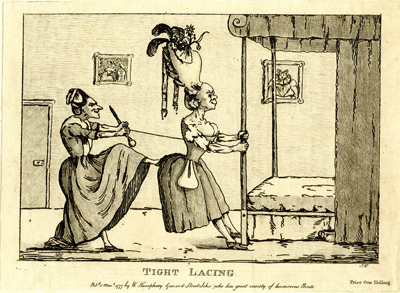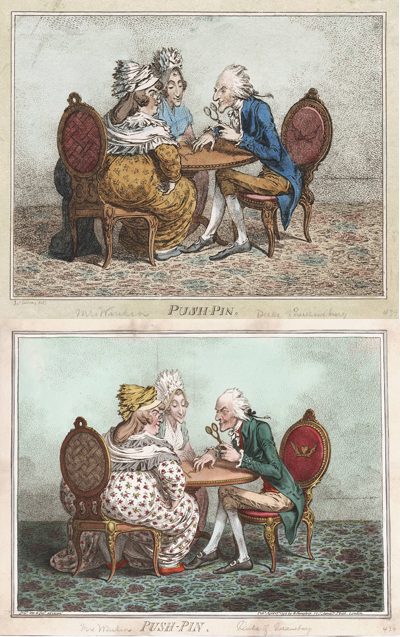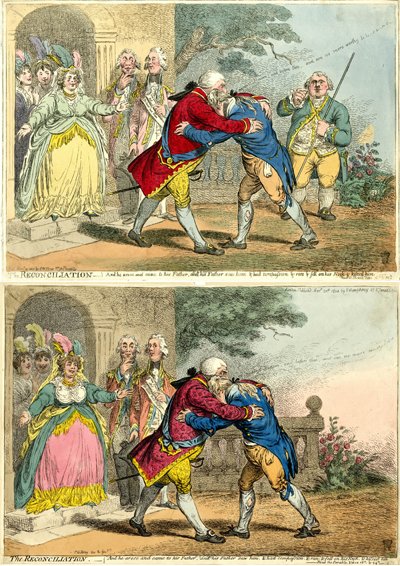Gillray's Works

Tight Lacing [March 5, 1777]
© Trustees of the British Museum
Identifying a Gillray
Identifying a print by Gillray is not always easy. Early on in Gillray's career, he didn't sign his prints, his characteristic style was still evolving, and sometimes, according to Dorothy George, he purposely disguised his prints as the work of other caricaturists (like RS - Richard Sneer, John Hamilton Mortimer, or James Sayers). So it is not unusual to find that a given print is listed as a Gillray in one collection and by someone else in another. A complete consensus has yet to emerge.
Later on when he was well-known, Gillray was sought after as an engraver/etcher of designs by amateurs and other artists. And as a freelance engraver for hire, we can safely assume that he took the commissions. In those cases, his characteristic style was submerged to varying degrees to meet the requirements of his customers. Where the original source drawings have survived, as in most of the prints in the Eloquence series (1795) and Farmer Giles & His Wife Shewing off Their Daughter Betty. . . (1809) in the British Museum, for instance, we can see for ourselves how much of the finished print belongs to Gillray and how much to another designer.
With other prints, however, we may feel that something of the incisiveness of the satire and the artistry in the arrangement of figures is lacking and suspect that Gillray is working from someone else's design, but until we find an amateur's drawing or a source drawing by Gillray himself, we are left to make educated guesses.
At the risk of stating the obvious, then, here are some basic questions to ask when trying to decide whether a print is by Gillray.
- Do any of the major collections list the print as a Gillray?
- Is the publisher of the print one that Gillray was working with at that time?
- Are the portrayal of the figures in the print consistent with the portrayals of those figures in known, contemporaneous, Gillray prints?
- Is the skill of figure arrangement and perspective consistent with other Gillray prints at the time?
- Are the etching and coloring style consistent with Gillray's practice at that time? Thanks to the "zoom" feature provided by collections such as the British Museum, Lewis Walpole Library, the Princeton University Library, and the National Portrait Gallery, in many cases, you can now examine both these key indicators from your own desktop.

Miller & Blackwood (Top) 17 x 21 cm.
Humphrey (Bottom) 24 x 31 cm.
© Lewis Walpole Library, Yale University
Is It Authentic?*
Assuming that the title and general appearance of a print has a match in one of the major Gillray collections, the next obvious question, is: "Is the print authentic?". Once again, the question cannot be eaily answered. In spite of William Hogarth's efforts to protect the work of painters and engravers like himself from plagiarism, there was little enforcement of copyrights, and as the preeminent political satirist, Gillray's ideas and designs were regularly stolen by other caricaturists and his published prints copied with varying degrees of skill and success.
Of course, the quickest and easiest way to copy a Gillray was to make a tracing of the orginal print and then use that tracing to etch a new plate. But in that case, the figures would be reversed from the original and (since sloppiness was obviously not a concern for these art thieves) Gillray's smaller, meticulous strokes of definition would likely be missing. Such crude copying was not uncommon in Gillray's time and continues even to this day.
In at least two instances, copies of Gillray's prints were made, but at slightly reduced sizes. From 1798
to 1808,the German periodical, London und Paris, etched and produced copies of Gillray's prints
(with fascinating early commentaries) in reduced versions to fit their publication specifications.
After Gillray's death in 1815, the Scottish publishing house of Miller and Blackwood seems to have hoped to
capitalize on Gillray's reputation by issuing a multi-volume edition of copies of Gillray's prints with
accompanying commentaries. Nine volumes, incorporating 72 prints, were published from 1818 to 1824. A tenth volume was
planned but never published. In both these cases, the reduced size of the print compared to a Gillray original in one
of the major collections should be a sufficient indicator. But again since the copies were scaled down by
a hand other than Gillray's, subtle and not so subtle differences in the images can be detected. In the case
of Push-Pin, for instance, differences in the hair and chin of the Duke of Queensberry are readily apparent
as are the length of his shoes and the shading of his stockings.

S.W. Fores (Top)
Hannah Humphrey (Bottom)
© Trustees of the British Museum
Another source of copied Gillrays was S.W. Fores, for whom Gillray actually worked from around 1786 until 1791. But perhaps unhappy about Gillray's defection to Hannah Humphrey, Fores began using another caricaturist, Charles Williams from 1803 to 1807 to copy popular Gillray prints. These copies should be identifiable by the Fores publishing line on the bottom of the print. But some less than reliable dealers may crop the Fores publication line and try to represent the print as Gillray's. So if a print contains no publisher's line, a close comparison of the etched strokes with a reliable original might still be necessary. In the case of The Reconciliation (1804), Gillray's "signature" has been replaced by the Fores publishing line, tears have been added to Pitt, Moira, and Queen Charlotte, and the gazes of Pitt and Moira have been redirected. But the most obvious difference is that Fores and Williams have introduced the Earl of Dartmouth, Lord Chamberlain, as an additional observer. Not content with that change and perhaps to forestall a charge of plagiarism, they have dated the print two days earlier than Gillray's to suggest that Gillray copied Williams. Whatever effect it may have had at the time, it hasn't worked in the long run.
Gillray must have been aware of these thefts, and it is not unlikely that his increasing and seemingly manic addition of strokes to an image like The Reconciliation was, in fact, intended to make it more difficult to counterfeit.
But there is yet another issue. And it stems from the fact that we are talking about prints, not original drawings or paintings. Once Gillray was finished with the copper plate incorporating his design, prints from the plate could continue to be run off as needed. If a print proved particularly timely and popular, a second, roughly contemporaneous, run of the print might be necessary. And popular social prints such as La Belle Assemblee, The Gout, and Very Slippy Weather could be reissued months or even years after their initial publication date whenever the current stock ran out. So even if the print was struck from an original Gillray plate, it could have been produced any time after the original publication date and colored at that time or even later.
The Humphreys, both Hannah and her nephew George who took over the business in 1818, continued to sell individual Gillray prints and collections of Gillray's works using the original plates long after Gillray's death. Since these prints would be mostly sold to wealthy patrons or Gillray collectors, they were likely to have been reproduced on better and thicker paper stock than the initial run, and the tone, no longer supervised by Gillray himself, could be different. All of these would be strictly authentic, i.e. produced from Gillray's orginal etched plate, but they would not have been a first edition so to speak.
One potential indicator of an early production date is the paper it is printed on. Gillray prints published before 1792/3 tend to be on laid paper which can usually be identified by a regular pattern of lines across the print which is visible when you hold it up to a light. After 1793 the prints coming out of Hannah Humphrey's shop seem to be mostly on wove paper. But there was definitely overlap. Billingsgate Eloquence and Quizzing a Filly (1795) at the Lewis Walpole Library, for instance, are both listed as on laid paper. So far as I know, paper usage by Gillray and Hannah Humphrey is an area that is virtually unexplored, and could be useful in dating prints if more were known.
In 1830 Thomas McLean published The Genuine Works of James Gillray, Engraved by Himself. In Two Volumes based on Gillray's plates. The two volumes included 610 prints in coloured and uncoloured editions. Depending upon the size of the prints, sometimes more than one print appeared a page, and one or more additional prints appeared of the reverse side of the page. In 1852, Henry Bohn followed suit with a collection of uncoloured Gillray's prints in two volumes; 582 in the first volume and 45 so called "suppressed plates" in the second.** Like the McLean edition, the plates were arranged on both sides of the page to minimize the total number of leaves in the folio But unlike McLean, Bohn numbered the plates in the upper right-hand corner of each print. So if your print contains different images on both front and back of the sheet, it has likely been cut from either the McLean or Bohn editions. And if you can find a plate number engraved on the print it is most likely from the Bohn edition. But if you can see a faint image of the same print on the reverse side of a page, the print is almost certainly not from a McLean or Bohn edition, but may have come about from the practice of stacking freshly inked prints before they had completely dried.
* Thanks to Mathew Crowther at The Printshop Window for providing much of the information about Gillray editions in this section. But any errors are my own responsibility. I welcome any corrections or additions.
** While the plates were in his hands, Bohn seems to have produced coloured versions of specific plates for customers willing to pay a premium. Those prints generally follow the Humphrey coloring and are of high quality. But so far as I have been able to determine, there was no authorized coloured Bohn edition.